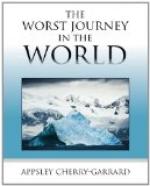In very low temperatures the snow crystals become very small and very hard, so hard that they will scratch the runners. The friction set up by runners in such temperatures may be known as rolling friction, and the effect, as experienced by us during the Winter Journey and elsewhere, is much like pulling a sledge over sand. This rolling friction is that of snow crystal against snow crystal.
If the barometer is rising you get flat crystals on the ice, if it is falling you get mirage and a blizzard. When you get mirage the air is actually coming out of the Barrier. Thus far Wright’s lecture.
Since we returned I have had a talk with Nansen about the sledge-runners which he recommends to the future explorer. The ideal sledge-runner combines lightness and strength. He tells me that he would always have metal runners in high temperatures in which they will run better than wood. In cold temperatures wood is necessary. Metal is stronger than wood with same weight. He has never used, but he suggests the possible use of, aluminium or magnesium for the metal. And he would also have wooden runners with metal runners attached, to be used alternately, if needed.
The Discovery Expedition used German silver, and it failed: Nansen suggests that the failure was due to the fact that these runners were fitted at home. The effect of this is that the wood shrinks and the German silver is not quite flat: the fitting should be done on the spot. Nansen did this himself on the Fram, and the result was excellent. [I believe that these Discovery runners were not a continuous strip of metal but were built up in strips, which tore at the points of junction.] Before it is fitted, German silver should be heated red hot and allowed to cool. This makes it more ductile, like lead, and therefore less springy: the metal should be as thin as possible.
As runners melt the crystals and so run on water, metal is unsuitable for cold snow. For low temperatures, therefore, Nansen would have wooden runners under the metal, the metal being taken off when cold conditions obtained. He would choose such wood as is the best conductor of heat. He tried birch wood in the first crossing of Greenland, but would not recommend it as being too easily broken. In the use of oak, ash, maple, and doubtless also hickory, for runners, the rings of growth of the tree should be as far apart as possible: that is to say, they should be fast growing. Ash with narrow rings breaks. There is ash and ash: American ash is no good for this purpose; some Norwegian ash is useful, and some not. Our own sledges with ash runners varied enormously. The runners of a sledge should curve slightly, the centre being nearest to the snow. The runners of ski should curve also slightly, in this case upwards in the centre, i.e. from the snow. This is done by the way the wood is cut. Wood always dries with the curve from the heart towards the outside of the tree.




